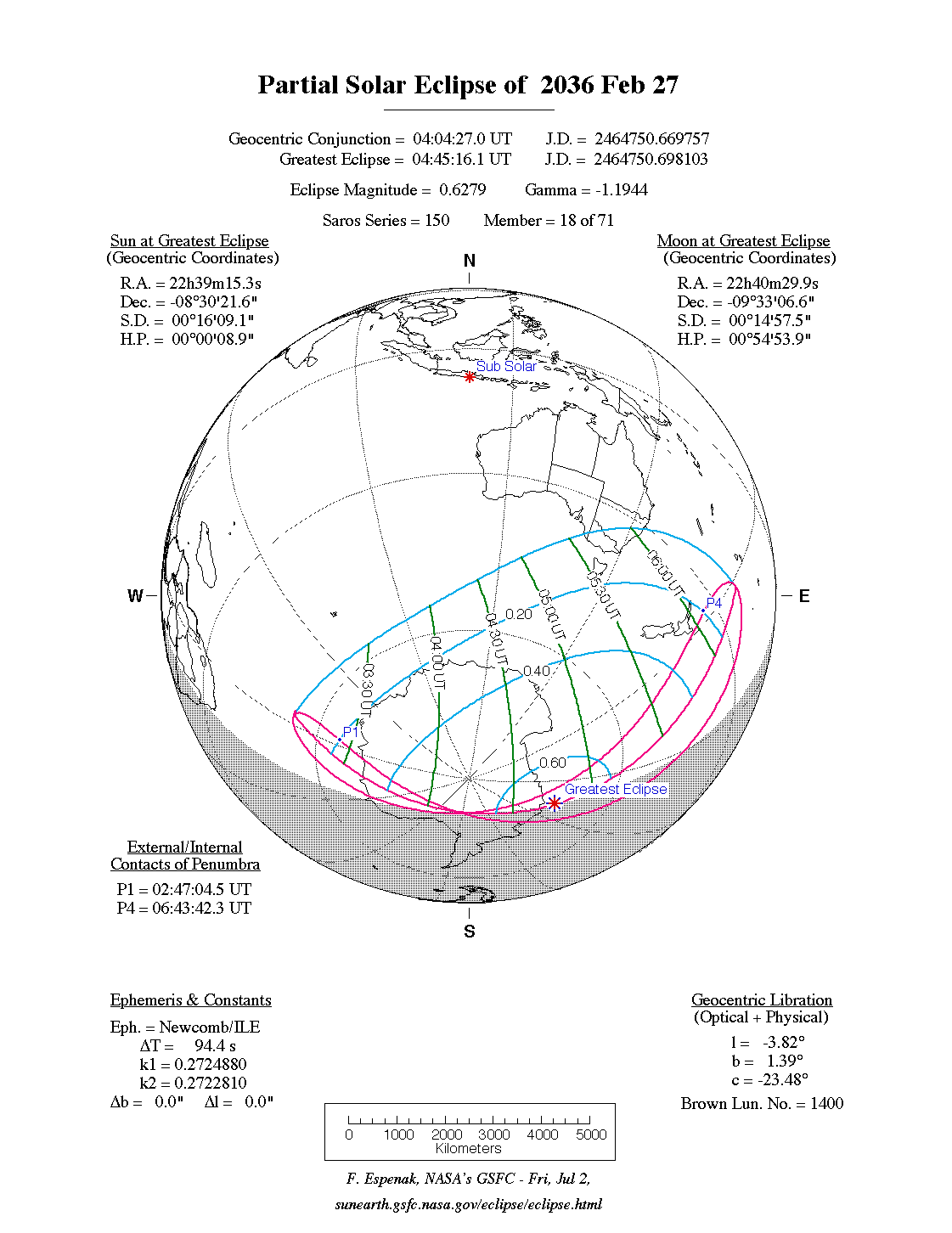A partial eclipse of the Sun occurs on Wednesday 27 February, 2036 UT, lasting from 02:47–06:43 UT. A moderate partial eclipse, with 63% of the Sun covered for viewers closest to the center, will create an interesting spectacle for observers in south-eastern Australia, New Zealand, and Antarctica.
The timings of the phases of the overall eclipse
worldwide are as follows. In any particular
place it will be seen for a significantly shorter
duration as the shadow moves across the Earth:
| Partial eclipse begins: |
02:47:04 UT |
| Maximum eclipse: |
04:45:16 UT |
| Partial eclipse ends: |
06:43:42 UT |
During this eclipse the Sun will be 0.538° in apparent
diameter, 1.0% larger than average. The Moon will be just 4 days past apogee, making it very small.
At maximum eclipse it will be 0.498° in apparent
diameter, which is 6.1% smaller than average. This has no real
effect on this eclipse, since the Moon's central
shadow misses the Earth, making this a partial eclipse.
The statistics page has information on the ranges of the sizes of
the Sun and Moon, and the Moon data page displays detailed
information on the Moon's key dates.
Overview Map
This map sourced from NASA Goddard Space flight Center: GSFC Eclipse Web SiteGSFC Eclipse Web Site
The primary source of all the information on eclipses presented here at Hermit Eclipse. (NASA Goddard Space flight Center)
shows the visibility of the partial solar eclipse. (Click on it for the
full-sized version.)
Eclipse Season and Saros Series
This eclipse season contains 2 eclipses:
This is the 18th eclipse in solar Saros series 150.The surrounding eclipses in this Saros series are:
This Saros series, solar Saros series 150,
is linked to lunar Saros series 143. The
nearest partner eclipses in that series are:
Eclipse Parameters
| UT Date/time (max) | 04:45:27 on 27 Feb UT |
TDT Date/time (max) | 04:46:49 on 27 Feb TDT |
| Saros Series | 150 |
Number in Series | 18 |
| Penumbral Magnitiude | |
Central Magnitiude | 0.6286 |
| Gamma | -1.1942 |
Path Width (km) | 0 |
| Delta T | 1m22s |
Error | ± 0m17s (95%) |
| Penumbral Duration | |
Partial Duration | |
| Total Duration | |
| |
| Partial Rating | none |
Total Rating | |
| Sun Distance | 148128812 km (21.4%) |
Moon Distance | 399424 km (85.5%) |
| Sun Diameter | 0.538° |
Moon Diameter | 0.498° - 0.498° |
| Apogee | 03:16 on 23 Feb UT |
Perigee | 02:39 on 10 Mar UT |
| Contact p1 | 02:47:04 on 27 Feb UT |
Contact p2 | |
| Contact u1 | |
Contact u2 | |
| Max eclipse | 04:45:16 on 27 Feb UT |
| Contact u3 | |
Contact u4 | |
| Contact p3 | |
Contact p4 | 06:43:42 on 27 Feb UT |
Note that while all dates and times on this site (except
where noted) are in UT, which is within a second of civil time,
the dates and times shown in NASA's eclipse listingsGSFC Eclipse Web Site
The primary source of all the information on eclipses presented here at Hermit Eclipse. (NASA Goddard Space flight Center)
are in the TDT timescale.
The Sun and Moon distances are shown in km, and as a
percentage of their minimum - maximum distances; hence 0%
is the closest possible (Earth's perihelion, or the
Moon's closest possible perigee) and 100% is
the farthest (aphelion, the farthest apogee).
The statistics page has information on the ranges of sizes
of the Sun and Moon, and the Moon data page displays detailed
information on the Moon's key dates.
Data last updated: 2018-06-10 08:31:28 UTC.

